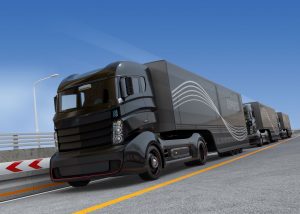The path to zero-emission trucks and a 100% clean energy future
The transportation sector is at a crossroads: zero-emission trucks have the potential to cut pollution that causes climate change and harms human health. However, a transition away from diesel pollution will require strong leadership from policymakers and private sector executives alike.
That opportunity was front and center last week, when EDF hosted a Climate Week 2020 panel discussion on new initiatives that will spur electrification in the transportation sector. So, too, was the urgent need to act: The transportation sector accounts for one-quarter of global carbon dioxide emissions. And urban cargo trucks burning dirty diesel are fouling the air, causing the deaths of nearly 10,000 people annually in the U.S. alone.
Here are four major takeaways from the panel, which included representatives from Air Alliance Houston, Northeast States for Coordinated Air Use Management, and Ryder trucks.
Truck pollution hits vulnerable communities hardest
“On-road sources of air pollution disproportionately burden communities of color and low-income neighborhoods due to their proximity to roads and vehicular traffic,” Dr. Bakeyah Nelson, executive director of Air Alliance Houston, noted in her presentation.
She used Houston’s Fifth Ward as an example. An air quality mapping study (conducted by EDF) showed nitrogen oxide levels 48% higher in the Fifth Ward than in the rest of the city. Metal recycling and concrete batch plants in the neighborhood are magnets for heavy-duty vehicles. The Fifth Ward is also home to a larger than average population of people of color, individuals facing chronic illnesses and residents who struggle financially.
The path to zero-emission trucks and a 100% clean energy future Share on XTimothy O’Connor, senior director in EDF’s energy program, noted that while heavy-duty trucks account for only 4% of all vehicles on U.S. roads, they are responsible for nearly half of all smog-forming pollution and nearly 60% of fine particulate (soot) pollution, endangering public health. And these numbers are projected to rise over 25% by 2030, underscoring the urgent need to quickly transition to a zero-emission future.
State leaders are already embracing zero-emission vehicles
Coralie Cooper, deputy director, Northeast States for Coordinated Air Use Management shared examples of how states and municipalities have advanced zero-emitting trucks and buses, like Connecticut and New York who have committed to zero-emitting procurement in their bus fleets. California also passed the Advanced Clean Trucks rules stipulating that an increasing percentage of trucks manufactured in the state must be zero-emission.
State leaders are creating a template that other states and jurisdictions can follow, Cooper said.
According to O’Connor, “Making this happen will require strong national, state and local public policy — and significant commitment to zero-emission trucks by fleet owners and manufacturers. Fostering awareness of the harm of diesel pollution among company executives, policymakers and community leaders is also key to getting clean trucks on the road.”
A zero-emission transportation future is possible
Leaders in the for-profit, non-profit and public sectors have to be driving policies that will result in a much faster market transformation than what current industry projections show, O’Connor said. At least 30% of all new trucks and buses sold in the U.S. must be zero emitting no later than 2030 in order to acheive our mid-century climate goals. Committing to this target is particularly important at a time when fuel use and miles traveled grow year over year, and are projected to increase as consumer and commercial goods are transported at greater rates via delivery trucks and tractor-trailers.
The good news is that progress is underway. In July, NESCAUM announced an agreement between 15 states and the District of Columbia that will dramatically increase the number of zero-emission trucks and buses on the road. The agreement calls for a ZEV Action Plan to ensure that 30% of new truck and bus sales are zero emitting by 2030 and 100% by 2050.
Corporate leadership will play a key role
Chris Nordh, senior director of Advanced Vehicle Technology and Energy Products at Ryder, said companies are playing a key role in the transition away from diesel engines. He spoke about Ryder’s commitment to meeting their customer’s needs with a lower environmental footprint, and also about a new truck sharing platform Ryder developed called COOP, to get electric trucks into customers’ hands. “Think of it as Airbnb for trucks,” he said. It’s a way for manufacturers to let customers (in this case, fleet owners like municipalities or commercial enterprises) try demo fleets without significant upfront costs.
Nordh also spoke about corporate ZEV deployment in last-mile delivery. “You’re seeing very significant commitments from FedEx and UPS that are implementing in the thousands at this point as opposed to two vehicles at a time.”
O’Connor also weighed in on the importance of corporate leadership and action, making the point that “broad and ambitious commitments by leading companies demonstrates the viability of the movement toward zero while also quickening its pace by establishing a supportive undercurrent for additional industry actions and public policies.” He referenced Amazon’s new partnership with e-truck manufacturer Rivian and the recent Walmart announcement to invest in a zero-emission fleet nationwide for their 18-wheelers.
The national move toward zero-emitting trucks and buses in the United States will not happen without a concerted commitment by truck manufacturers and fleet owners working alongside policy makers and public health advocates. As O’Connor noted in his closing comments, when we link statistics on air pollution and public health to diesel truck pollution, and in turn, to consumer choice and demand, we will see greater movement toward achieving EDF’s national goals.











